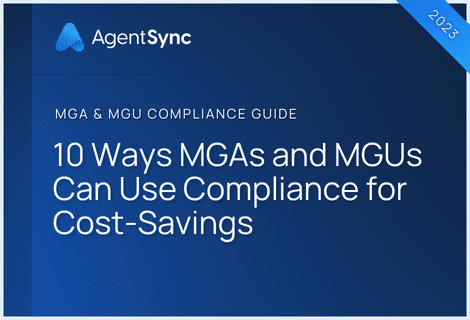

No one ever promised that operating an MGA or MGU would be “cheap.” But did you anticipate that compliance would be such a large cost center for your organization? Compliance isn’t optional, and MGAs/MGUs have unique and complicated obligations when it comes to managing producer compliance.
Are MGAs/MGUs responsible for producer compliance?
Despite the historical trend of placing the burden on upstream carrier partners or downstream agency partners, MGAs/MGUs are in fact responsible for ensuring they only do business with producers working with valid licenses.
Assuming you want to stay on the right side of all applicable laws and regulations, you can’t ignore compliance. MGAs/MGUs, just as much as insurance carriers and agencies, have to pay attention to the license status of each producer they work with, in each state that producer works in, and in each line of business that producer sells.
You can do this by dedicating significant resources, in terms of staff members and the hours they spend manually managing compliance. Or you can do it in a modern, automated way that ultimately saves cost by avoiding the necessity of adding headcount just to tackle producer compliance management.
As the economy faces high inflation and a potential recession, MGAs/MGUs have to look at places to cut costs as much as any other business. Because MGAs/MGUs are responsible for producer compliance, you can look to your compliance management process for cost savings without sacrificing any of your responsibilities.
Why is MGA/MGU compliance expensive?
MGAs/MGUs are uniquely positioned as intermediaries that take on, or have the ability to take on, some traditional carrier responsibilities. This means your compliance activities may range from onboarding new producers, tracking their license status across resident and nonresident states, appointing them with carriers, paying commissions, and more. When you multiply this complexity by the number of producers you’re managing, and their compliance needs across every up- and downstream business partner, it’s a sizable undertaking.
MGA/MGU compliance management the old fashioned way
MGAs/MGUs can choose to tackle compliance in the same way most carriers and agencies have historically done it. But that means someone at your MGA/MGU has to understand the nuances of insurance regulations across states and lines of authority, then keep up with ever-changing regulatory requirements. This role requires significant tenure and expertise in the industry and means you need dedicated, specialized staff for this purpose.
If you choose to go this route, finding and keeping dedicated compliance staff becomes a challenge when in an industry already facing a talent shortage and a mass retirement wave. Attracting and retaining people whose main purpose is to cross reference spreadsheets, PDFs, and state departments of insurance websites is a losing proposition in 2023.
Even if finding people to do the job isn’t your issue, if your MGA has people doing the labor-intensive work of manually tracking producer compliance, that’s headcount on your payroll who aren’t generating revenue. They’re not even doing revenue-supporting work like building client relationships or engaging with new up- and downstream business partners.
Modern MGA/MGU compliance management
Instead of bringing on new people who’ll devote hours and hours a day to manually monitoring and verifying producer license compliance, your MGA could go a more modern route and adopt a digital solution that’s built to solve these exact compliance challenges.
How much would manual compliance management cost your MGA?
You might not be spending a lot of money on producer compliance right now, but if you want to invest in ensuring you’re pulling your weight in the compliance process, you’ll need to make some investments. If you choose to do this the old fashioned way, with manual work done by dedicated compliance experts, it gets expensive quickly.
The cost of stagnant growth
Your MGA’s or MGU’s growth goals might include onboarding new producers to sell new lines of business in new geographic markets with new carrier partners. But how many compliance staff will you need to do this without risking landing in regulatory hot water? And how much will that cost?
If you can’t shoulder the added cost of bringing on dedicated compliance staff, you could always task your current team with the duties. This will add hours of manual work into their weeks, which is a losing proposition and could even lead to higher turnover as current team members become dissatisfied with added tedious administrative tasks.
Without a plan to tackle your compliance obligations, you might have to just put those growth plans on hold. Meanwhile, competing agencies and MGAs/MGUs that have already automated their producer compliance can scale at a speed you can’t even fathom and capture marketshare and carrier relationships that you’ve left on the table.
The cost of risk
Managing producer licensing and compliance on paper, with spreadsheets, or by any other manual and human-based method is full of risks.
The more complex your compliance picture, the more risk is involved. What seems reasonable for an MGA/MGU with 50 producers working in one or two states and with only a few carriers quickly becomes a minefield of risks when it grows to 200 producers working across all 50 states with 15 insurance companies. A common mistake MGAs/MGUs make is not planning for the compliance impacts of that kind of scale and growth in their early stages, leaving them in a crisis state when they grow, or simply unable to grow at all.
When you consider the risks of doing things the way you’ve always done them, consider each of these elements:
Compliance risks: What are the chances that one of your producers has a license that’s expired in one of the states they’re currently selling in? Do you know with 100 percent certainty that every producer in your distribution channel is properly licensed in every state and appointed with every carrier both when they sell and when commissions are paid?
Security risk: How secure is your and your clients’ information? Are you storing personal identifiable information? What types of information security protocols are in place? Have you invested in best-in-class information security measures and training for all staff? What are the chances someone has access to information they shouldn’t have, or that secure information is being kept in unencrypted documents – or even on someone’s desk?
Reputation risk: What would it cost to repair your reputation if your organization made headlines because of a compliance misstep or security breach? Have you considered the financial ramifications of not only immediate legal defense, but public relations work and lost business from customers or investors who decide to leave after a public incident?
The cost of lost distribution channels
On top of being unattractive to internal talent, manual compliance management can make your organization an unappealing partner to the up- and downstream distribution partners you need to fuel your growth.
Without insurance carriers, you have no products to offer your clients. And if your internal processes make it hard for carriers to get their insurance business in front of consumers, or present risks the carriers aren’t willing to take, then you’re going to be hard pressed to sell policies.
Without producers, you may have products to sell, but sales don’t just “happen.” If your internal processes make it hard for producers to get onboarded and selling quickly, they’ll choose to take their talent elsewhere and work for an agency or MGA/MGU that enables them to do more, faster, and frictionlessly.
Each of these risks comes with real financial costs. With the economic outlook in flux, and businesses looking to save money in case a looming economic recession materializes, these costs aren’t ones you want to leave to chance.
How much does compliance automation cost?
To answer this question, you’ll have to look at your current costs versus the cost of implementing an automated producer compliance management solution. We predict, when you look at the full picture, that the cost of the right solution will be less than continuing to do things the way you’ve always done them.
While you’ll have to pay for a solution, to be sure, the savings you’ll get back when you let your staff devote time to revenue-generating activities that they want to be doing (not tedious tasks they’d rather not be doing) will pay dividends.
We can’t tell you exactly what your ROI, or the resulting true cost of automating compliance for your MGA/MGU will be (unless you speak with one of our team members about your specific situation!). But here are a few hypotheticals to consider. If your agency is in a similar situation to any of these, you can do some ballpark math to calculate your ROI.
- Your MGA/MGU works with 10 downstream producers who spend an average of one hour daily on administrative work related to their many state licenses and carrier appointments, tracking continuing education credits, renewal deadlines, etc. These same producers could call five new leads, or quote three prospects, or consult with a client about an upcoming renewal, or close a new deal in that same hour. How much revenue are you losing when you have producers sending emails and checking in on their licenses instead?
- One of your top downstream agency partners just onboarded five new, highly promising producers who came from other agencies with proven track records. The agency’s recruiting team spent months trying to entice them away from their prior agency and finally convinced them to join up. Unfortunately, due to the manual nature of getting them appointed, verifying their license status in different states, and all the other onboarding steps, it’s been four weeks (and counting) and these producers still aren’t out there selling. The new producers are frustrated, not making any money, and costing your agency-partner every day they’re sitting in license limbo. In a worst-case scenario, this might be enough to make them reconsider their decision to join the agency at all. Not only does this cost real money immediately because these producers (who were selling for different carriers at their previous agency) are now not writing business, it also harms your relationship with your best distribution channel partner and could impact future business with them.
- Your MGA/MGU has two tenured employees who manage operations and agency relationships. You’ve now added compliance management into their job descriptions. These employees now have to spend hours cross-referencing spreadsheets and various state DOI websites on top of their regular duties. One of the employees is close to retirement and finding someone to fill the position is going to be nearly impossible with the current state of insurance talent. In the meantime, the non-retiring employee can’t possibly double their workload. Would the cost of automating the bulk of manual compliance tasks be worth it to relieve someone of tedium so they can focus on the work that only they can do, without the cost (in both time and money) of finding and training a replacement for the retiree?
Here’s what our customers say:
“I can manage all of our licenses by myself. I wouldn’t be able to do that if not for AgentSync, or I would work 100 hours a week and I would still be behind. The system is just very manageable and so easy.”
“As we grew, we needed to be strategic about how we were handling licensing and compliance. It was clear that having the ability to manage tasks with the click of a button versus taking hours out of our day would be key to our sustained growth.
“Improving our internal administrator experience was a huge part of our decision to partner with AgentSync. In our past process, we would need to click eight different screens and open up eight different windows just to get an agent reviewed and approved. With AgentSync, our entire process exists in a single system through a centralized top to bottom workflow.”
The cost-savings of real-time automated insurance regulatory compliance
Welcome to 2023. We don’t know what the future holds in terms of the world economy, but we know insurance will always be vital to making it run.
As you navigate the economic uncertainty of the coming year, faced with the constraints of tightening budgets, less headcount, and ever-growing revenue goals, you may want to look at the cost-saving benefits of real-time, automated producer compliance solutions.
If you aren’t using technology to support your team’s efforts, you’re wasting time and money investing in manual compliance management. Instead, focus on integrated solutions that automatically update regulatory requirements and plug in accurate producer compliance throughout all of your business workflows.
Ready to see how much money your managing general agency or underwriter could save by automating compliance and letting your humans do more valuable work? Download the Guide: 10 Ways MGAs/MGUs Can Make Compliance a Cost Saver to learn more about what to look for when you’re trying to automate producer license compliance for maximum cost savings.
Key Takeaways:
- MGAs/MGUs are trying to balance staying in compliance with shrinking budgets, increased revenue goals, producer and staff recruitment and retention, and an uncertain economic outlook.
- MGAs/MGUs often don’t think producer compliance falls on their plate, counting on upstream carriers and downstream agencies to carry the burden. In fact, MGAs/MGUs are responsible for producer compliance.
- With the understanding that MGAs/MGUs need to care about compliance, they can do so manually, or in a modern, digital way.
- Managing producer compliance the way it’s been done historically is manual, tedious, and error-prone work that doesn’t have the speed, ease, or efficiency your up- and downstream distribution partners and clients expect.
- Continuing to manage compliance manually creates risks both in terms of hard financial costs and in other areas like reputation and information security.
- MGAs/MGUs can dramatically reduce the financial cost of compliance along with many of the other risks you’re currently facing through real-time automated compliance solutions.

